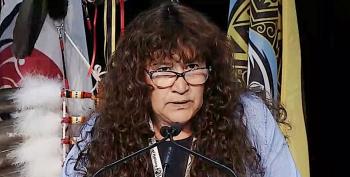Image Caption
Summary
Windspeaker.com Writer
A table flipped off the stage sending water glasses smashing to the floor when Bonnie Leonard approached the podium at the Assembly of First Nations Annual General Assembly on July 25 in Fredericton.
The startling occurrence, just seconds before Leonard was to launch into her presentation, was perhaps foreshadowing the tumult expected over the next two years as chiefs-in-assembly work to renew the AFN charter.
Leonard, a lawyer and former chief of the Kamloops Indian Band, is the “lead technical” with the AFN Charter Renewal Committee, which Chair Harold Tarbell joked as he turned the microphone over to Leonard, was ready “to kick ass.”
Leonard acknowledged that hers would be a difficult presentation, but merely an introduction to the work ahead, which she described in hurricane–type categories, outlined by degree of contentiousness.
“This is the hurricane — category 3” items, said Leonard.
Voting “is a hot topic.”
“What about proportional voting. Presently, we have one Band, one chief, one vote. However, one Band might have 110 members and they still have one vote. What about a Band that has 20,000 members and still have one vote? Is that fair? What are our options? We need to explore that.”
Another hot topic is the continued existence of the Confederacy of Nations, one of the arms of the AFN organization. It’s supposed to be the governing body of AFN between assemblies, said Leonard. It is to review and enforce decisions and direction of the First Nations-in-Assembly, including interpreting resolutions.
Its role, in part, is to ensure the accountability of the AFN to the First Nations by taking corrective and remedial disciplinary measures “where willful breach of the national mandate has occurred.”
The composition of the confederacy is one representative per region, with an additional representative for every 10,000 First Nations citizens in that region.
“However, it’s no longer being utilized formally,” Leonard explained. Though it was briefly revived in 2014 as a result of leadership concerns over the First Nations Control of First Nations Education legislation negotiated by the AFN with the ruling federal Conservatives.
Should the charter be revitalized to get this body back up and running, asked Leonard. Or should the confederacy be taken right out and its roles and responsibilities be put onto the executive committee?
Funding for the AFN comes from Canada, and there are often concerns that the relationship between the AFN and Canada is too close. Must there be distance formally created in the charter for the AFN, a lobby and advocacy body, by finding revenue sources other than government transfers?
And what happens if AFN “gets into the economic development game and starts competing with our communities? That could be problematic,” Leonard explained.
Category 2 items will include membership and the authority of the national chief.
“What power should the national chief have?” Currently, the national chief has no authority, unless directed by the First Nations or the AFN executive. The national chief is the spokesperson of the AFN, oversees budgets and provides reports.
Regarding membership: “There is no definition of First Nation in the AFN charter… The assumption is that it means Band under the Indian Act… Currently, Indian Act Bands and chiefs vote, but what about hereditary chiefs or clan leaders or other traditional leaders? If they are going to vote, what’s that process that we’re going to adopt to allow that to happen?”
Also requiring consideration are nations that have entered into modern Treaty or self-government agreements, no longer operating under the Indian Act.
“How is their voice heard at this organization, or should it be?”
Category 1, Leonard believes, will be items that may be fairly easy to reach consensus on, to either keep in the charter, or make minor changes to, like the preamble of the charter; its statement of values.
“I like to think of those as your motherhood terms, your motherhood provisions in any kind of declaration that you pass. And I think we can all agree with those. They were good back in 1985 and they remain relevant,” she said.
Another item for consideration in this category is to include a provision that requires a national chief (as well as regional chiefs) to take an oath of office. The current charter lacks this. There is also no provision in the charter for chiefs’ committees. She also suggests looking at defining portfolio parameters.
The original charter was ratified in 1985. It was last updated in 2003. With leadership calling for more amendments, a comprehensive review of the charter was done in 2005. Attached to that review’s report were 47 recommendations for change, but “for some reason they were never formally adopted and they weren’t implemented,” said Leonard.
In 2017 a resolution was passed that a chiefs’ committee be established on renewing the charter, focused on nation rebuilding and how the AFN can support that work.
To amend the charter requires 60-days notice to First Nations and that changes be done at an annual meeting or a special meeting of the First Nations in Assembly.
The work of charter renewal is expected over two years, but Leonard said she’s hearing that the timeline is not good enough. “We want to do this faster.”
To that end, the chiefs play an important role in getting the work done sooner, she said
“We need to find consensus. I can only provide you with options and you are in charge of this,” she told the delegates.
The full AFN charter can be found at https://www.afn.ca/about-afn/charter-of-the-assembly-of-first-nations/

